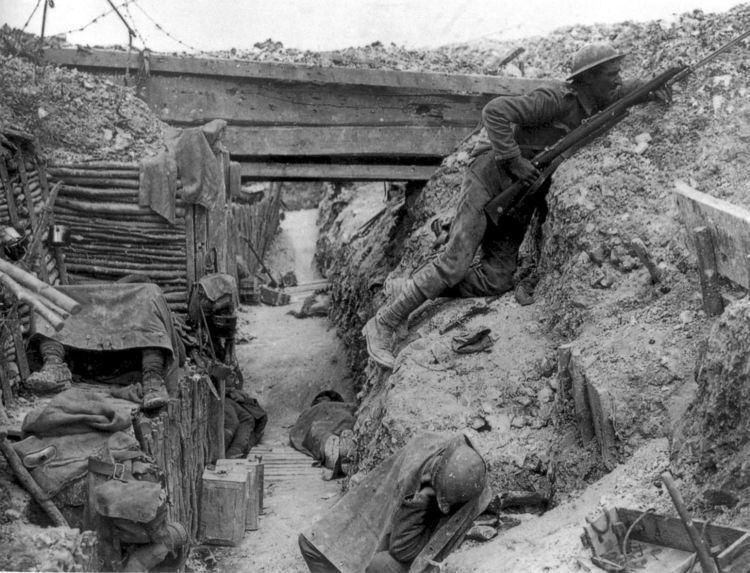Entrenching battalions were temporary units formed in the British Army during the First World War. Allocated at Corps level, they were used as pools of men, from which drafts of replacements could be drawn by conventional infantry battalions.
The practice ceased on the Western Front by autumn 1917, due to manpower shortages, but saw a revival at the start of 1918. The reduction in the number of battalions in an infantry brigade (from four to three) resulted in many (under-manned) infantry battalions being disbanded. Following the disbandment of these infantry battalions in February 1918, the pool of men was used to bring the remaining battalions up to strength, and to allocate any remaining manpower surplus to twenty five entrenching battalions. These battalions were put to use in improving the existing defences in anticipation of a German offensive, and could be used as a reserve force if needed.
The Entrenching Battalions were disbanded in April 1918, with their troops apportioned to infantry battalions to make good the losses suffered following Operation Michael, the German spring offensive of 1918. Many of their war diaries from 1918 have survived and can be consulted at the National Archives at Kew though the 1918 war diaries for the 1st, 6th, 7th, 10th, 13th, 15th and 17th Entrenching Battalions have not survived.
In addition to the entrenching battalions of the British Army, there were also entrenching battalions in both the Canadian Expeditionary Force and the Australian Imperial Force (the 1st Anzac Entrenching Battalion). In addition, the New Zealand (Māori) Pioneer Battalion served with the New Zealand Expeditionary Force.
1st Entrenching BattalionThe Battalion appears to have been stationed in Salonika in 1918.
2nd Entrenching BattalionThe Battalion appears to have been stationed in Salonika in 1918. The unit was commanded by
Hubert Carr-Gomm.
3rd Entrenching BattalionFormed from a number of battalion elements.
4th Entrenching BattalionFormed primarily from the disbanded 13th Battalion
East Yorkshire Regiment, and a small number of former members of 14th Battalion
York and Lancaster Regiment (aka 2nd Barnsley Pals), although many of the 2nd Barnsley Pals were to join the 1st Barnsley Pals.
5th Entrenching BattalionFormed from the 13th Battalion
Cheshire Regiment, 8th Battalion Bedfordshire Regiment, 9th Battalion
Suffolk Regiment and 8th Battalion Loyal North Lancashire Regiment.
6th Entrenching BattalionFormed from the 11th Battalion Kings Own (Royal Lancaster) Regiment.
7th Entrenching BattalionFormed from the Nelson Battalion, Royal Naval Division and 8th (Service) Battalion, The South Staffordshire Regiment.
8th Entrenching BattalionRefer to article on 1914-1918.net for further details; see "External Links" below.
9th Entrenching BattalionFormed from the 3rd Battalion,
Monmouthshire Regiment.
10th Entrenching BattalionFormed from the disbanded 8th Battalion East Yorkshire Regiment and 12th Battalion
West Yorkshire Regiment. Disbanded on 5 April 1918. These men subsequently joined the 7th Battalion East Yorkshire Regiment and 10th Battalion West Yorkshire Regiment.
11th Entrenching BattalionFormed from the
Household Battalion, a battalion raised from the
Household Cavalry.
12th Entrenching BattalionFormed from elements of the 23rd Battalion
Manchester Regiment. The Officer Commanding was Lieutenant Colonel L M Stevens DSO.
13th Entrenching BattalionFormed from the 10th (Service) Battalion, The Gloucestershire Battalion.
14th Entrenching BattalionFormed from the 7th Battalion, Kings Own Yorkshire Light Infantry.
15th Entrenching BattalionFormed from the 8th Battalion, East Lancaster Regiment.
16th Entrenching BattalionFormed from half of the disbanded 6th Battalion King's Own Yorkshire Light Infantry.
17th Entrenching BattalionFormed from elements of the 18th Battalion Manchester Regiment The battalion was with the 49th Infantry Division during the Spring Offensive.
18th Entrenching BattalionFormed from the 12th Battalion,
Middlesex Regiment.
19th Entrenching Battalion20th Entrenching Battalion21st Entrenching BattalionFormed from the 10th Battalion, Royal Irish Rifles.
22nd Entrenching Battalion23rd Entrenching BattalionFormed from the 14th Battalion Royal Irish Rifles and 11th Battalion
Royal Inniskilling Fusiliers.
24th Entrenching BattalionFormed from the 2/5th (TF) Battalion
Royal Warwickshire Regiment and the 2/4th & 2/6th (TF) Battalions
Gloucestershire Regiment.
25th Entrenching BattalionFormed from the 2/1st Buckinghamshire Battalion and the 2/8th (TF) Battalion Royal Warwickshire Regiment. These men subsequently joined the 2/4th Oxfordshire & Buckinghamshire Light Infantry when the battalion was disbanded in April 1918.

